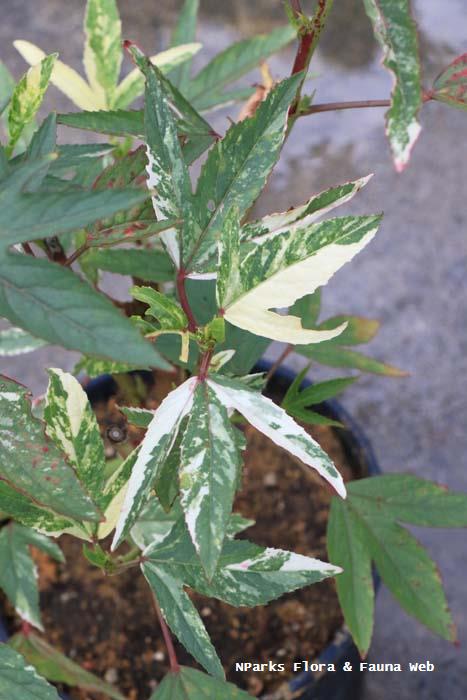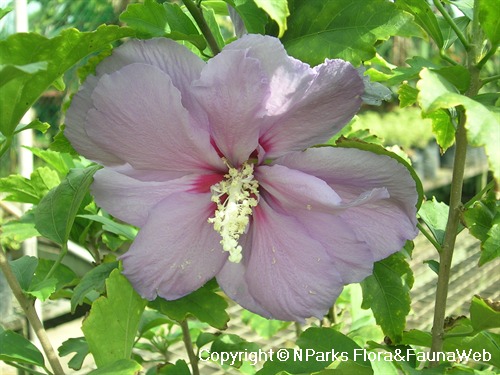
Back
Hibiscus acetosella Welw. ex Hiern
| Family Name: | Malvaceae |
| Synonyms: | Hibiscus eetveldianus |
| Common Name: | False Roselle, Rose Mallow, Red-Leaf Hibiscus, Cranberry Hibiscus |
Name
Classifications and Characteristics
| Plant Division | Angiosperms (Flowering Seed Plants) (Dicotyledon) |
|---|---|
| Plant Growth Form | Shrub |
| Lifespan (in Singapore) | Perennial |
| Mode of Nutrition | Autotrophic |
| Plant Shape | Shrubby |
| Maximum Height | 2 m |
Biogeography
| Native Distribution | Tropical Africa |
|---|---|
| Preferred Climate Zone | Tropical |
Description and Ethnobotany
| Foliage | Simple alternate leaves are slightly glossy and pubescent, deep red in colour and shape of lower leaves is usually shallowly to deeply palmately with 3 to 5 lobes but upper leaves are become undivided, with a distinct nectary located at base of midrib. Petiole dark red. |
|---|---|
| Flowers | Flowers are solitary and bisexual, borne between the leaf axils with five petals that are pink in colour and lasting only a day. Petals are wine red with a dark purple centre, giving the flower a distinctive “eye” in the center. Self-pollination most commonly occurs for the flowers of H. acetosella but outcrossing by insects may occur too. |
| Fruit | Fruit a red ovoid capsule that is many-seeded. Seeds reniform (= kidney-shaped) to globular, dark brown when ripe, and verruculose (= minutely verrucose, i.e. bearing wart-like projections on the surface). |
| Others - Plant Morphology | Plant Growth Form: Erect annual or short-lived perennial herb or shrub that grows to 0.5 – 2.5 m tall, usually entirely red or with a marked red flush. |
| Cultivation | Introduced as a vegetable or ornamental plant into Southeast Asia, H. acetosella is sometimes grown as a colourful temporary hedge. Red forms are popular ornamentals that are also grown in the temperate regions as frost-tender annuals. Grows on all kind of soils, but requires good drainage. A cultivar, H. acetosella ‘Red Shield’, has brilliant maroon leaves.Propagated by seed and stem cuttings. Diseases that are known to affect H. acetosella are soilborne diseases, such as Rhizoctonia solani and Sclerotium rolfisii. |
| Ethnobotanical Uses | Edible Plant Parts : Edible Fruits, Edible Leaves, Edible Flowers Food (Fruit or Vegetable) Others: Food: A common home garden, vegetable, the sour and slightly mucilaginous leaves are eaten as a side dish with rice and also added in small quantities to several dishes. The red flowers and possibly also the leaves are occasionally used to make a tea, somewhat similar to the use of the red calyces of the roselle (Hibiscus sabdariffa). The root is edible but insipid and fibrous. Medicine: In Angola, an infusion of the leaves in water is used as post-fever tonic and as medicine to treat anaemia. In East Africa, children with an aching body are washed in cold water to which some mashed H. acetosella leaves have been added. |
Landscaping Features
| Desirable Plant Features | Ornamental Foliage, Ornamental Fruits |
|---|---|
| Landscape Uses | Container Planting, Flowerbed / Border, Hedge / Screening, Focal Plant |
Fauna, Pollination and Dispersal
| Pollination Method(s) | Abiotic (Self-Pollinated) |
|---|
Plant Care and Propagation
| Light Preference | Full Sun |
|---|---|
| Water Preference | Moderate Water |
| Plant Growth Rate | Moderate |
| Rootzone Tolerance | Fertile Loamy Soils, Well-Drained Soils, Easy to Grow, Disease / Pest Resistant |
| Maintenance Requirements | Low |
| Propagation Method | Seed, Stem Cutting |
Foliar
| Mature Foliage Colour(s) | Red |
|---|---|
| Foliar Type | Simple / Unifoliate |
| Foliar Arrangement Along Stem | Alternate |
| Foliar Shape(s) | Non-Palm Foliage (Palmate) |
| Foliar Margin | Palmately Lobed |
| Typical Foliar Area | Microphyll ( 2.25cm2 - 20.25 cm2 ) |
| Leaf Area Index (LAI) for Green Plot Ratio | 4.5 (Shrub & Groundcover - Dicot) |
Floral (Angiosperm)
| Flower & Plant Sexuality | Bisexual Flowers |
| Flower Colour(s) | Pink |
|---|---|
| Individual Flower Shape | Trumpet-shaped |
| Ovary Position | Superior / Hypogynous |
| Flower Lifespan on Plant | 1 Day |
| Flowering Habit | Polycarpic |
Fruit, Seed and Spore
| Mature Fruit Colour(s) | Brown |
|---|---|
| Fruit Classification | Simple Fruit |
| Fruit Type | Dehiscent Dry Fruit , Capsule |
Image Repository
Others
| Master ID | 795 |
|---|---|
| Species ID | 2090 |
| Flora Disclaimer | The information in this website has been compiled from reliable sources, such as reference works on medicinal plants. It is not a substitute for medical advice or treatment and NParks does not purport to provide any medical advice. Readers should always consult his/her physician before using or consuming a plant for medicinal purposes. |








